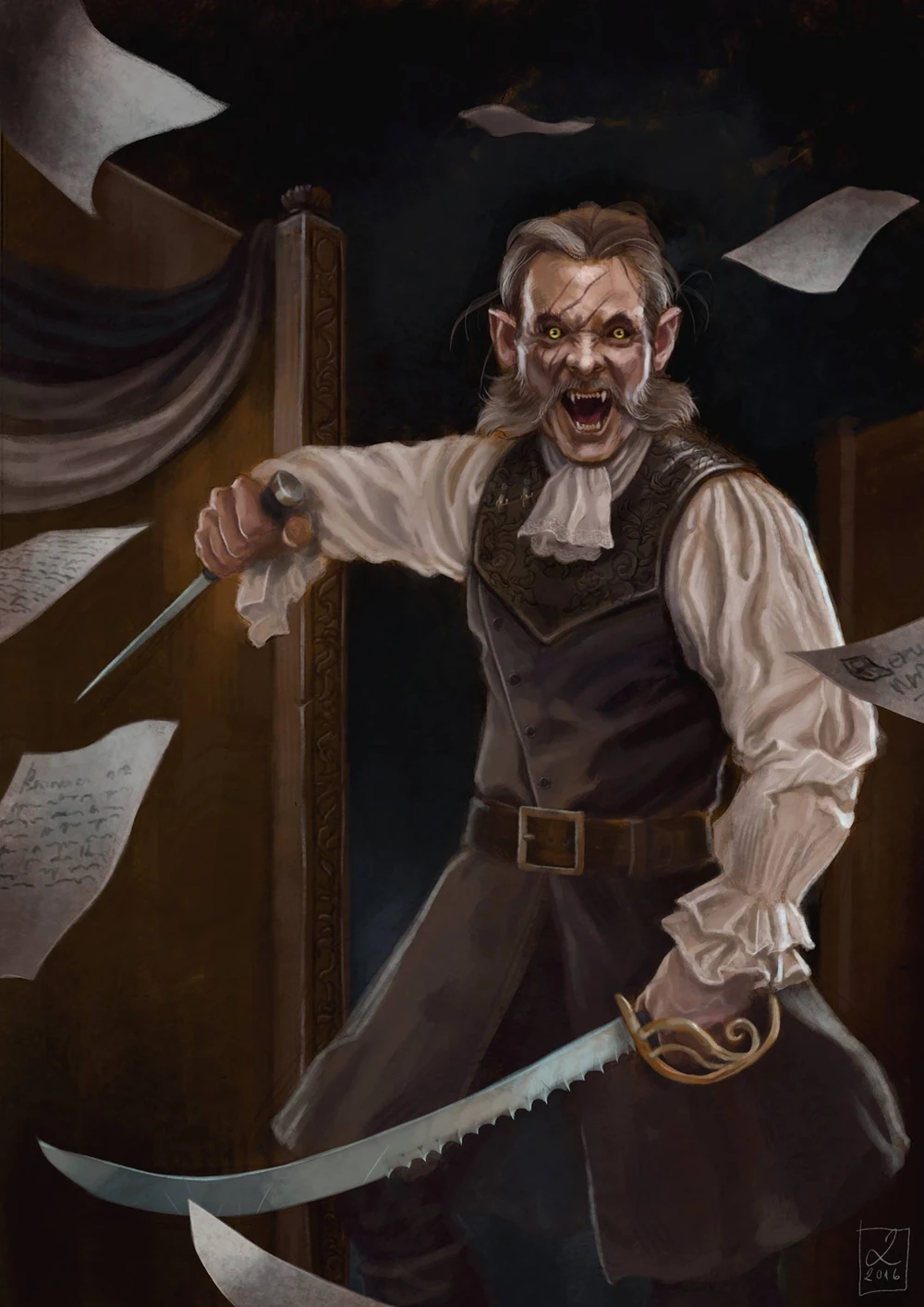VAMPIRE (n. masc.)
From The Encyclopaedia of His Arch-Royal Majesty Ferdinand II
One of the two anthropomorphic races of monsters inhabiting the World, distinguished by the absence of sleep and by the necessity of introducing human blood into the organism for the maintenance of life.
The Vampire is the least numerous of the three anthropomorphic races, its total population being estimated at approximately one hundred and seventy thousand. Of these, some one hundred and twenty thousand reside in Neuland, where the Vampires possess their own cantons; around forty thousand dwell in Guntreland; about five thousand in Tildeland; roughly one thousand in Hederven; and several hundreds are dispersed throughout the independent archipelagic states. Only in Bautia is their number insignificant, as it has likewise become in Sigisland after the Legislations of Archking Ferdinand II.
Contrary to the Werewolf, whose average span of life is shorter than that of Man, the Vampire enjoys a life longer than that of the human species. His chief external characteristics are pronounced canine teeth, an elongated and supple figure, long pointed nails, and a complexion of remarkable pallor. He displays singular agility in climbing walls, employing the elasticity of his body and the strength of his sharpened claws, by which he fastens himself to the surface and maintains equilibrium.
It is beyond doubt that Vampires have no need of sleep, nor can they slumber or experience fatigue. Daylight, on the other hand, is exceedingly disagreeable to them—especially direct exposure to the sun’s rays, which produces a reddening of the skin, itching, and a burning sensation, appearing either immediately or shortly after exposure, and often persisting for several weeks. For this reason they pass the day in darkened chambers illuminated solely by candles, and not seldom lie in closed coffers, cellars, or subterranean vaults—whence arose the ancient belief that Vampires are the living dead.
Castles, palaces, and dwellings built for Vampires are easily recognised by the circumstance that their doors and windows face exclusively northward, for from that quarter the sun’s rays never fall. All bodily excretions of the Vampire are of a red hue.
According to the traditions of the people and the writings of learned men such as Birotus and Pemus of the pre-Congressional era, there once existed Vampires of far greater power than those of the present day—beings said to have borne wings like those of the bat (see also: BAT), by which they could fly; to have endured daylight without harm; and whose hearts could be destroyed only by the thrust of a stake of hawthorn. The Arch-Royal Academy has not confirmed these assertions, though it is still commonly believed that Vampires conceal some portion of their powers in strict secrecy.
The conduct of the Vampire is directed and for the most part determined by his continual necessity of obtaining blood from without. This arises from a still-imperfectly-understood limitation of his body to produce blood of sufficient quality, which tends to degenerate in proportion to his activity. The Vampire introduces blood through the mouth, either by biting a man or a werewolf, or by drinking the blood freshly shed. Upon the ingestion of blood, the organism of the Vampire is quickened: his countenance takes on a rosy hue, and for a few moments, until he opens his mouth, he may be mistaken for a human being. Yet as the interval since his last feeding lengthens, the beating of his heart grows slower and fainter, and his entire frame becomes lethargic.
In that condition his need for air likewise diminishes, so that a Vampire well fed and well drunk may survive for several days beneath the earth, or in other places where air is scarce. Should such a state endure for too long, the Vampire may expire altogether.
Vampires are born in the same manner as men, for their reproductive system continues to function unimpaired so long as they receive blood in sufficient quantity. The child of a Vampire father and a Vampire mother is invariably a Vampire; whereas from mixed unions may be born either men, true Vampires, or Vampirelings (see: VAMPIRELING). A second manner of origin may, though not necessarily must, occur when the blood of a human becomes infected by the saliva of a Vampire: in such a case, the person may appear to die within forty-eight hours of the bite, and some weeks thereafter the brain and heart may revive, and he becomes a Vampire.
Among the most notable evidences of this is the case, in the time of Archking Ferdinand II, of Abraham Ginter, a criminal sentenced to death, who was subjected to an experimental bite by a Vampire. After receiving the bite, Ginter expired, then returned to life as a Vampire, and lived for six months within the building of the Academy as assistant in the chemical laboratory, until he perished in an explosion together with Doctor Ruben, then head of the Academy’s Department of Vampirology.
The common practice among nearly all nations—to pierce with a hawthorn stake the corpse of any person who had been bitten by a Vampire, lest such a transformation occur—has not been experimentally tested by the Academy, though numerous indications suggest that it might indeed prove efficacious.
If a Werewolf be bitten by a Vampire, he does not thereby become a Vampire, but a Dracopyr (see: DRACOPYR), displaying extraordinary ferocity; whilst animals bitten by Vampires commonly exhibit heightened aggressiveness beyond their ordinary disposition, yet acquire not the true characteristics of Vampirism.
The possibility of becoming a Vampire through the bite greatly facilitates the propagation of the species, in contrast to Lycanthropy, which can be transmitted only by birth within a lycanthropic lineage. Nevertheless, Werewolves are born more readily than Vampires, among whom the proportion of stillborn offspring is considerable; thus, throughout the world, Werewolves are reckoned to be twice as numerous as Vampires.
By drinking the blood of diseased men, Vampires may themselves become infected with the same maladies from which those men suffered; and the blood of those who have perished of old age is generally distasteful to them, being incapable of wholly satisfying their physical requirements. A Vampire who drinks the blood of a Werewolf likewise becomes a Dracopyr, as happens conversely with the latter—hence the rarity of such occurrences. Vampires who substitute animal for human blood are known as Wild Vampires, and they lose the faculties of self-command and of speech, as has been confirmed by the investigations of the Arch-Royal Academy. Nearly all Vampires by nature experience a profound dread of water.
The characteristics of the Vampire, as herein described—and in particular the strength of his craving for blood—demonstrate the peril which this race presents to mankind. When the need for blood becomes imperative, the Vampire, driven by the primal instinct of self-preservation, is capable of assaulting, grievously wounding, or even slaying a human being. Certain vampirological researches of the Archroyal Academy have shown beyond question not only that members of this species display a peculiar predilection for human blood, but also that the act of drinking from the neck of a dying victim affords them the highest conceivable delight; and that no other mode of introducing blood into their system can furnish even a comparable degree of satisfaction.
Protection against Vampires may be achieved in several ways. Chief among the substances most noxious to them is the plant of white garlic, which acts upon their respiratory passages and bloodstream, producing a desiccating effect and reducing the Vampire’s body to dust. According to traditional belief—which accords with the preliminary results of experiments undertaken by the investigators of the Arch-Royal Academy—almost all Vampires feel an intense terror at the sight or thought of the blood of a crowned human Sovereign, which may be physically harmful to them.
By reason of the peculiar reaction of silver with the blood of Vampires, this metal is more deadly to their race than steel; hence the widespread but erroneous popular belief that the body of a Vampire cannot be wounded by steel, but only by silver.
In Sigisland, in the elder times, the Vampires—availing themselves of their natural aptitudes, of the long hours granted them by their freedom from sleep, and of their powerful sense of mutual fellowship—attained with remarkable speed to vast riches, erected castles, and acquired the rank of nobility.
His Archroyal Majesty Ferdinand I, in the third Congress-year, recognized as of the First Estate some five thousand Vampires, and granted to as many more the privileges of the Second Estate—although the Monarch himself was by no means well-disposed towards that race, being ever mistrustful of them, and continually endeavouring to shield mankind from their excesses. He permitted the Vampires to purchase blood from men, yet forbade them upon pain of death to bite them.
Through their wealth the vampiric nobility attained to great influence after the earthquake and the conflagration of Kelenburg in the year 87, in the outbreak of which they themselves are suspected to have borne no small measure of guilt—though every vestige of proof was, in all likelihood, carefully concealed (see: THE KELENBURG FIRE). The period of their ascendancy was marked by contracts of a peculiar kind, in which Vampires lent gold to men who, in return, pledged their blood as security for the debt; and such covenants remained lawful even until the reign of Ferdinand II, albeit in many cases they entailed the death of the debtor who must redeem his obligation with his own blood.
The Vampires, being nigh unto power, likewise employed their position to manifest their rivalry toward the Werewolves; and in the year 95, under their influence, His Archroyal Majesty Ferdinand-Paulus enacted the Lycanthropic Legislation, by which all Werewolves were, under pain of death, banished from Sigisland.
In the ensuing period the power and station of the Vampires within Sigisland continued to grow, despite the ever-increasing tokens of danger inherent in such mingling with mankind. Under the reign of Ferdinand-Engelbert I, in the year 110, when rumours spread that peasants dwelling near the castle of Velstein in Otterlon—whose lord was a Vampire—had begun to vanish mysteriously, physicians dispatched to investigate observed in the male Vampires of the Velstein house an extraordinary vitality and an unusual tolerance of sunlight, and in the female Vampires of that lineage a strangely rejuvenated skin.
The conclusion of their report—that the sole plausible explanation of these phenomena lay in the practice of those noble Vampires bathing in the blood of abducted peasants, mingled with the essence of certain rare nocturnal flowers peculiar to the environs of Castle Velstein[1]—was disregarded, and remained in the strictest secrecy until the time of His Majesty Ferdinand II. Although the inquiry led to the arrest of the entire family and the cessation of further outrages, the Archroyal Court of Justice acquitted Count Velstein and his kin, allegedly for want of proof (see: THE VELSTEIN AFFAIR).
At that time the half-ruined Kelenburg was inhabited almost exclusively by Vampires and their retainers, while the Sigislandite Sovereigns resided in Ferdinandshafen, each maintaining in his council several noble Vampires who vigorously advanced their own race’s interests. The most renowned among them, Münhstenflüve (see: MÜNHSTENFLÜVE), Arch-Chancellor under the reigns of two Sigislandite Monarchs—Ferdinand-Engelbert II and Engelbert II—from the year 141 to 153, proposed statutes whereby the blood of all persons condemned to death or to corporal punishment should be rendered the property of the Vampires; but both sovereigns steadfastly resisted such measures.
From the very moment of his accession, Ferdinand II set himself firmly against the vampiric influences at court, and in consequence, in the year 169, founded the Department of Vampirology within the newly established Arch-Royal Academy (see: ACADEMY), dedicated to the protection of mankind from the natural powers and advantages of the Vampire race. In the year 171 he issued a series of ordinances regulating the conduct of their nobility, imposing just taxation upon their nocturnal revenues and mercantile undertakings; and, moreover, for the lower orders he introduced a tax upon candles, which bore most heavily upon the vampiric populace.
The Archking’s conflict with the vampiric aristocracy reached its height during the Restoration of Kelenburg, to which that faction from the outset opposed itself—professing a wish to preserve the authentic ruins of the edifices of the Founders, while in truth regarding the enterprise as a mere pretext for the imposition of the taxes that oppressed them (see: THE RESTORATION OF KELENBURG). The taxes enacted by Ferdinand II, his perseverance in the rebuilding works, and his severity toward all who dared resist his decrees, brought about the emigration of a considerable number of Vampires, chiefly to their cantons in Neuland.
When, in the year 186, a widespread rebellion broke out in Guntreland, and secret para-governmental institutions arose upon that continent, Ferdinand II discovered that behind the clandestine “republican” administration there stood a confederation of Vampires and Werewolves, financed by the gold of the Sigislandic vampiric nobility. These powers perceived in the crowned monarchs of men, in the ancient laws, and in the sacred royal blood—in whose presence all monsters lose both their might and their very vitality—the greatest menace to their supremacy (see: THE VAMPIRE-WEREWOLF CONSPIRACY).
On the first day of July in the year 186, Ferdinand II promulgated the celebrated Vampiric Act, by which all Vampires were deprived of their titles, estates, and treasures in favour of the Archkingdom, and were banished from the realm of Sigisland. From the revenues thus acquired were completed the works of the Restoration of Kelenburg: its eighth golden dome was raised in the year 189, when the Archking solemnly returned to the restored Erzkoenighaus; and with the same funds were constructed the Arch-Royal Air-Fleet and the equipment of Ferdinand’s Armada.
Upon the other continents, Vampires have ever been regarded with greater suspicion.
According to Guntrelandic tradition, Afs the Exterminator—from whom descends the present House of Afsen—did slay with a stake of hawthorn the Vampiric King, after which the Vampires withdrew into the high mountains, far removed from the habitations of men. From that time forward the Vampires of Guntreland have lived in isolation; though on two later occasions, in the years 55 and 96, the Kings of Guntreland issued ordinances determining under what conditions the Vampires should be spared from death—imposing upon them grievous taxes, compulsory labour, prohibition of the purchase of human blood or of departure from the narrow tracts assigned to their dwelling, and rewarding every man who should slay a Vampire found beyond these bounds.
In consequence, many Vampires emigrated to Neuland, whilst others turned their fury upon the Werewolves, which gave rise to the increased appearance of Dracopyres.
A wholly different course was taken by the so-called “Republic of Guntreland”, that creation of the Vampiric-Lycanthropic Conspiracy whose principal aim was the maintenance of perpetual wars, whereby the Vampires might more readily obtain human blood. This “Republic,” by its Constitution of the Year 194, placed Werewolves and Vampires upon equal footing with men, abolishing all earlier laws which had protected mankind from their depredations.
Within its territory there were even established special nocturnal employments for Vampires, guaranteeing to each the means of earning, by honest labour, that sum of money necessary for the lawful purchase of human blood in the requisite quantity. Though the statutes of the “Republic of Guntreland” prescribed, for reasons of hygiene, that the delivery of such purchased blood among “citizens of the Republic” be conducted only under cleanly conditions and without physical contact between Vampire and man, yet at the executions of those Guntrelanders “placed outside the law” by the “revolutionaries,” the Vampires were invariably permitted to suck the blood from the bodies of their victims.
In this “Republic,” Vampires may be found among the “People’s Representatives,” among the officers of public administration, and even within the ranks of the army; and scientific knowledge concerning vampirism is there dismissed as superstition, with “Republican science” denying even the well-attested instances of the transmission of vampirism by the bite.
Tildeland maintains laws similar to those of the Guntrelandic monarchs; nearly all Vampires have emigrated thence, for in that country every consumption of human blood is unlawful, and Vampires are denied the right to possess land. In Hederven, they are forbidden to belong to guilds, and may purchase blood only through the mediation of the Blood Guilds, which, by their monopoly, greatly enhance its price.
In Bautia, the Vampires were almost entirely extirpated during the First False War (see: FALSE WAR), in which the challenger-duke Adler proclaimed them enemies both of the State and of the Army. Most of the Neuland cantons continue to enforce certain restrictive statutes against Vampires; yet, by permission of King Francis III and of the Federal Council, the Vampiric emigrants from Guntreland founded upon that continent three purely Vampiric cantons—Blutwig (Year 56), Ulstern (Year 97), and Vampirstrahe (Year 98). These cantons were admitted into the Federation as equal members by the Centennial Federal Act of the Year 100, and under circumstances not entirely free from suspicion soon acquired the foremost place in the exploitation of Neulandic gold and its commerce, purchasing mines in other cantons and founding banks of their own.
The United Archipelagic Confederation has never enacted laws against the anthropomorphic races; yet, owing to the Vampires’ natural dread of water, that insular realm has never possessed upon its soil any considerable number of them, nor have they there attained to notable influence.
Until the discovery of the Vampiric-Lycanthropic Conspiracy, it was universally believed that between these two races there reigned an irreconcilable enmity—a belief supported by innumerable tales and legends, from all continents, recounting the wars and conflicts between Vampires and Werewolves.
[1] This plant variety, the Welschtein orange flower, was exterminated from its natural habitat by order of Archking Ferdinand II; according to some beliefs, exiled vampires managed to take its seeds to Neuland and secretly preserve them from the rest of the world in order to overcome the harmful effects of the sun’s rays and prolong their youthful beauty.






